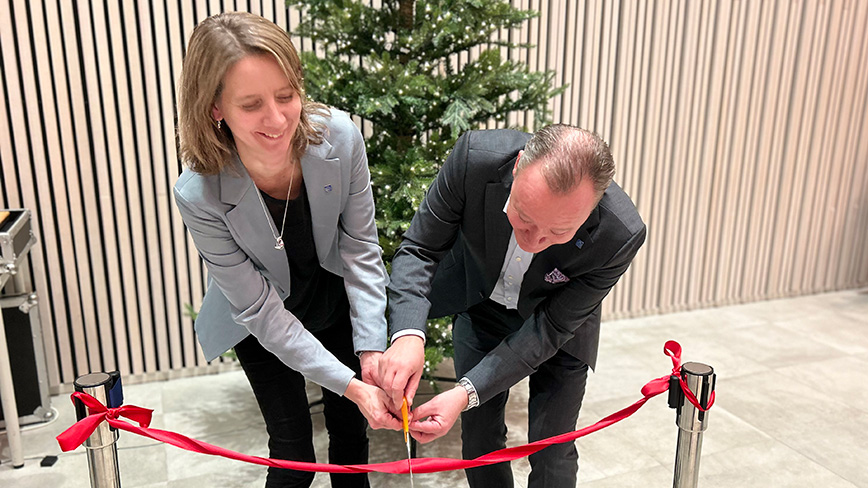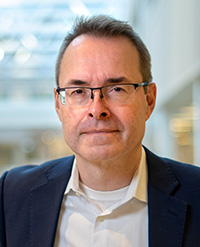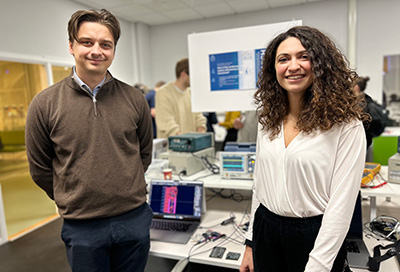Makerspace becomes Spaces with more rooms for the creative process

On 11 December, Flemingsberg's new Makerspace – Spaces – was inaugurated with pomp and circumstance. Head of School Amelie Eriksson Karlström and KTH's Deputy President Mikael Lindström were there to cut the ribbon. Many of the projects in Spaces are collaborative projects between students and researchers.
“With several rooms, designed and equipped for each part of the innovative process, we can really provide the right conditions for those who use the premises,” says Anders Cajander.

When the Makerspace in Flemingsberg was inaugurated in 2020, it was described as “a meeting place for students, teachers, researchers and industry, where students can take their projects to a new level”. During the years on floor six, many students have seen their project ideas take shape in real life, and there has been extensive support for developing solutions based on embedded systems, with everything from prototyping to being able to print 3D models and circuit boards on site.
But when floor six on the Flemingsberg campus was to be vacated, the Makerspace had to move too. Anders Cajander, lecturer and head of department – and the driving force behind the Makerspace – describes it as a bit of a struggle at first. How could you find an equivalent space?
“Change is always tricky, but once we saw the possibilities, we realised that we could do something better. The new space has a smaller main room, but several smaller side rooms. We soon realised that it would provide an even better opportunity for our students and researchers,” he says.
Improving learning outcomes
The new spaces also prompted a name change from Makerspace to Spaces. The new Spaces include an Ideation space, where you can lock yourself in and brainstorm, and a Zen space, where you can sit in silence and contemplate. There are also social spaces and spaces dedicated to entrepreneurial activities – for students and projects that need an office.
“When we opened the first Makerspace in 2020, there was no scientific evidence that it would do wonders for student performance. Today, there are published academic reports showing that it does. It has been shown that Makerspaces built with enclosed spaces, with other features associated with the innovative process, have been the most successful. Just as we have done with new Spaces,” says Anders.
“With multiple rooms, designed and equipped for each part of the innovative process, we can really provide the right conditions for those using the facilities.”
Education and research go hand in hand
But getting there requires several interacting factors, says Anders.
“Of course, you need support from the management, and that's something we've always had. Sebastiaan, Amelie and Micke have all contributed in various ways to the development of what Sebastiaan calls the Flemingsberg model – when education and research go hand in hand. Linus Remahl, who is the director of Spaces, is a fantastic mentor for the students. This is all about teamwork.”

Spaces provides everything the Makerspace had, providing everythiong needed for developing embedded systems, for the benefit of students and researchers working in medical and electrical engineering. It has now been complemented by similar facilities for those developing software for data-driven health. This means several well-equipped computer workstations and access to its own cloud. Many parts of KTH have donated surplus equipment in the form of servers that have made it possible to create their own cloud with significant computing power. According to Anders Cajander, this is a very cost-effective way to develop the next generation of AI solutions.
Students get to work on real projects and researchers can outsource assignments to students, thus freeing up their own resources.
Both the head of school and the Deputy President agree that a Makespace is good for the quality of education. But there are other benefits in addition to that, says Head of School Amelie Eriksson Karlström.
“Being able to test things yourself is not only useful. It's fun to try things out yourself and I think this is one of the reasons why so many students enjoy their time here in Flemingsberg and why we have such a good study environment," she says.
Text: Åsa Karsberg

